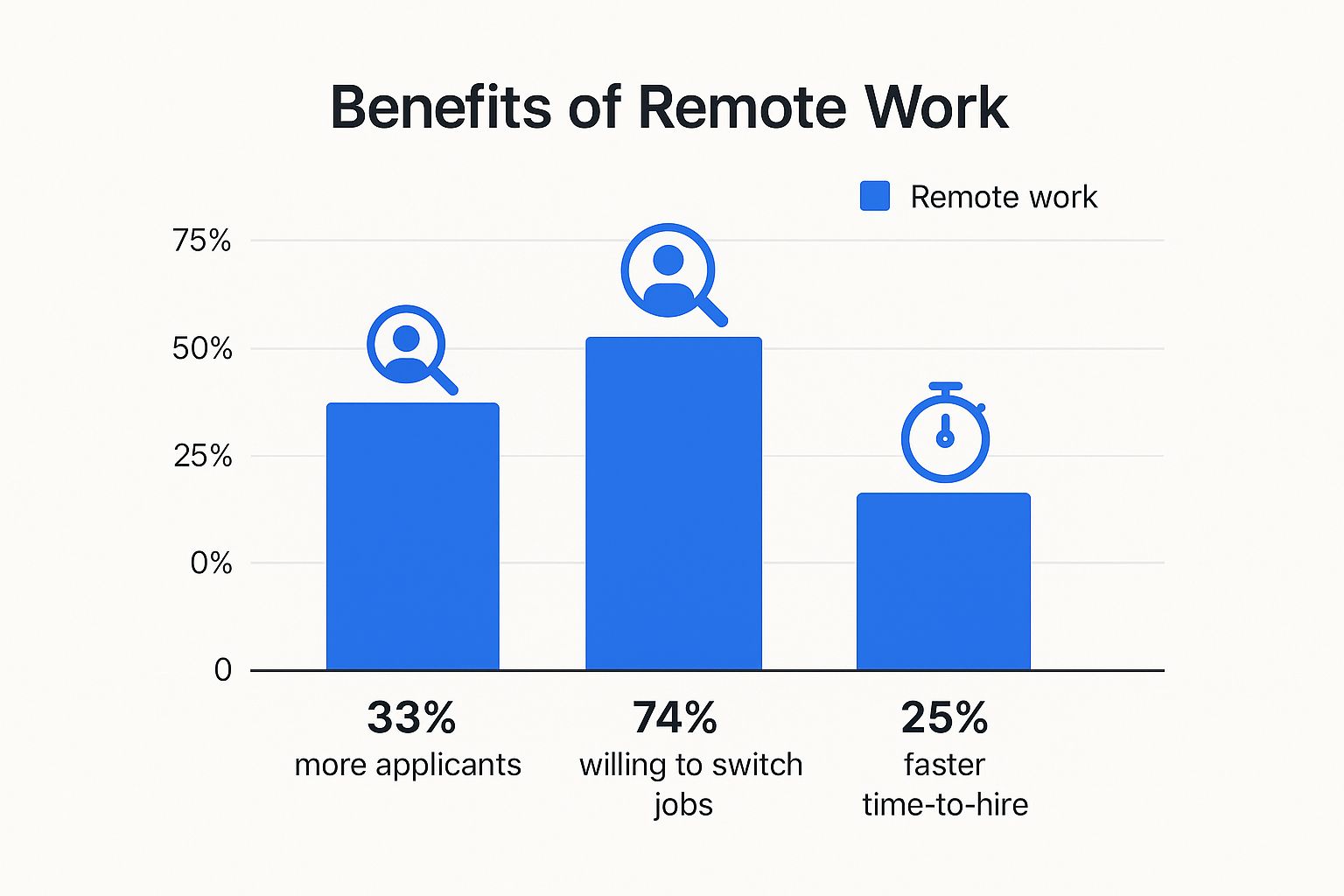8 Compelling Reasons for Work From Home in 2025

The professional landscape has fundamentally shifted, moving beyond temporary measures to a sustained embrace of remote work. This isn't just a trend; it's a strategic evolution driven by compelling data and tangible benefits for both employees and employers. While office-centric models once dominated, the conversation has now turned to efficiency, autonomy, and well-being. Understanding the core reasons for work from home is crucial for anyone navigating their career or shaping their company's future in this new environment.
This article provides a comprehensive look at the practical advantages of remote arrangements. We will move past surface-level observations to explore the eight most significant benefits, offering a detailed rundown of why this model has become a cornerstone of modern business strategy. For job seekers, this guide will arm you with persuasive arguments for negotiating flexible work. For employers, it will highlight the strategic gains of building a distributed team.
We will explore how remote work is not only reshaping individual productivity and enhancing work-life balance but also contributing to broader goals like environmental sustainability and business resilience. Each point is backed by actionable insights and real-world context, designed to illuminate the powerful, multifaceted case for remote roles. Whether you are a professional seeking a more fulfilling career or a leader aiming to attract and retain top talent, these points will clarify why flexible work is more than a perk; it's a competitive advantage.
1. Improved Work-Life Balance
One of the most compelling reasons for work from home is the profound improvement it offers to work-life balance. This concept refers to the equilibrium between an individual's professional responsibilities and their personal life, including family, health, and leisure. Remote work directly addresses this by eliminating the rigid structures and time sinks associated with traditional office environments, primarily the daily commute.
By reclaiming hours previously spent in transit, employees gain a significant block of personal time. This newfound flexibility allows for a more fluid integration of work and life duties. Instead of being confined to a 9-to-5 schedule in a specific location, remote workers can structure their day to accommodate personal appointments, school pickups, or mid-day fitness sessions without disrupting their professional output. This autonomy reduces stress and enhances overall well-being, leading to greater job satisfaction and life fulfillment.

Real-World Examples of Work-Life Integration
Several forward-thinking companies have successfully built their models around this benefit:
- Salesforce: With its "Work From Anywhere" program, Salesforce empowers employees to choose where and how they work, fostering a culture of trust and flexibility that prioritizes results over physical presence.
- Buffer: As a fully remote company, Buffer champions work-life integration. They encourage employees to design a work schedule that fits their life, not the other way around, leading to a highly engaged and loyal workforce.
- Patagonia: Known for its employee-centric culture, Patagonia's remote policies support its staff's passion for the outdoors, allowing them to balance their careers with their personal lifestyles seamlessly.
How to Achieve Better Balance at Home
Achieving this balance requires intentional effort. Without clear boundaries, the lines between work and home can blur, leading to burnout.
Key Strategies for Success:
- Establish Clear Boundaries: Designate a specific workspace and set defined work hours. Communicate this schedule to colleagues and family to manage expectations.
- Use Time-Blocking: Schedule specific blocks for work tasks, personal errands, and breaks. This creates a structured yet flexible routine.
- Create End-of-Day Rituals: Signal the end of the workday with a consistent action, like closing your laptop, changing clothes, or going for a walk, to mentally switch off.
By thoughtfully managing your time and space, you can harness the full potential of remote work. For more in-depth techniques, you can explore these powerful work-life balance strategies.
2. Cost Savings for Employees
A significant and tangible benefit driving the appeal of remote work is the substantial cost savings for employees. This is one of the most practical reasons for work from home, as it directly impacts an individual's financial health. The expenses tied to a traditional office job, from commuting to professional attire, accumulate quickly, and their elimination can translate into thousands of dollars in annual savings.
By removing the need to travel to a physical office, employees save on fuel, public transportation fares, parking fees, and vehicle maintenance. Beyond transportation, the daily costs of buying lunch, coffee, and work-appropriate clothing are drastically reduced. This financial relief effectively increases an employee's disposable income without any change in their salary, providing more capital for savings, investments, or personal spending.
Real-World Examples of Financial Benefits
Numerous studies and company reports have quantified these savings, highlighting the profound financial impact of remote work:
- Global Workplace Analytics: Research from this firm estimates that a typical employee can save between $2,500 and $4,000 per year by working from home, primarily from reduced spending on travel, food, and clothing.
- FlexJobs: A survey conducted by FlexJobs revealed that the average remote worker saves over $4,000 annually. This figure underscores the consistent financial advantage experienced across various roles and industries.
- Dell: The tech giant reported that its employees save an average of $5,500 per year on commuting costs alone, showcasing the massive potential for savings when travel is eliminated from the daily routine.
How to Maximize Your Savings at Home
To fully capitalize on these financial benefits, a strategic approach is necessary. Simple habits and proactive planning can amplify the money saved.
Key Strategies for Success:
- Track Home Office Expenses: Diligently track all expenses related to your home office, such as internet, utilities, and supplies. These may be eligible for tax deductions, further boosting your savings.
- Negotiate a Stipend: Discuss the possibility of a home office stipend or equipment allowance with your employer to cover initial setup costs and ongoing expenses.
- Plan Your Meals: Avoid the temptation of delivery services by practicing meal prep. This maximizes your food cost savings and is often healthier than takeout options.
By consciously managing these areas, you can ensure that working from home provides a significant boost to your financial well-being. To dive deeper, you can learn more about the financial benefits of remote work.
3. Increased Productivity and Focus
A significant and well-documented reason for work from home is the potential for increased productivity and focus. Contrary to initial skepticism, many employees find they can accomplish more when removed from the traditional office environment. This boost in output is often attributed to a reduction in common workplace distractions, such as open-office noise, casual interruptions from colleagues, and unscheduled meetings. The ability to control one's own environment allows for deeper concentration and more efficient task completion.
By creating a personalized and optimized workspace, remote employees can more easily enter a state of "deep work," a concept popularized by author Cal Newport. This autonomy to structure the day according to personal energy levels and peak focus times, rather than a rigid 9-to-5 schedule, often leads to higher quality work. The quiet and solitude of a home office can be a powerful catalyst for focused, uninterrupted effort, making it one of the most compelling reasons for remote work adoption.

Real-World Examples of Productivity Gains
Numerous studies and company models have validated the productivity benefits of remote work:
- Stanford Study: A landmark study led by Nicholas Bloom found that call center employees working from home showed a 13% performance increase, attributing it to a quieter work environment and fewer breaks.
- Prodoscore Research: During the pandemic-driven shift to remote work, Prodoscore data revealed a 47% increase in employee productivity, highlighting the efficiency gains possible outside the office.
- GitLab: As one of the world's largest all-remote companies, GitLab operates on a model of asynchronous communication and documentation that fosters deep work and maintains incredibly high levels of output across its global team.
- Automattic: The company behind WordPress.com has been fully distributed for years, proving that complex, large-scale projects can be managed effectively by a remote workforce focused on results over physical presence.
How to Maximize Focus at Home
Achieving peak productivity at home requires discipline and strategic planning. Without the external structure of an office, it's crucial to create your own routines.
Key Strategies for Success:
- Use the Pomodoro Technique: Work in focused 25-minute intervals separated by short breaks to maintain high concentration levels and prevent mental fatigue.
- Create a Dedicated Workspace: Designate a specific area for work that is free from household distractions to signal to your brain that it's time to focus.
- Batch Similar Tasks: Group related activities, like answering emails or making calls, into specific time blocks to minimize context switching and improve efficiency.
- Implement 'Do Not Disturb' Hours: Communicate specific times to your team and family when you will be unavailable for interruptions to protect your deep work sessions.
By implementing these habits, you can capitalize on the unique focus that remote work offers. To further refine your approach, you can dive into these proven remote work best practices.
4. Access to Wider Talent Pool (Employer Benefit)
A significant advantage for companies and one of the most strategic reasons for work from home is the ability to recruit from a global talent pool. By removing geographic constraints, businesses are no longer limited to candidates within commuting distance of a physical office. This opens up a vastly larger and more diverse pool of applicants, allowing organizations to find the best-qualified individual for a role, regardless of their location.
This approach allows companies to fill highly specialized positions that may be difficult to source locally and enriches the workforce with diverse perspectives and experiences. For job seekers, this means access to a wider range of opportunities without the personal and financial burden of relocation. This global marketplace for talent fosters a more competitive and dynamic professional landscape for everyone involved.
The data below visualizes the powerful impact that offering remote options can have on a company's recruitment efforts, highlighting key metrics in applicant volume, candidate willingness to switch roles, and hiring speed.

This bar chart clearly demonstrates that remote work is not just a perk but a critical competitive advantage in the hiring process, leading to a larger candidate pool and a more efficient recruitment cycle.
Real-World Examples of Global Hiring
Several pioneering companies have built incredibly successful, fully distributed teams by leveraging a worldwide talent pool:
- GitLab: As one of the largest all-remote companies, GitLab has team members in over 65 countries and famously has no physical headquarters, proving that a global workforce can scale effectively.
- Zapier: This workflow automation company has successfully grown a team of over 500 people distributed across more than 28 countries, fostering a strong culture of asynchronous communication.
- Shopify: With its "digital by default" policy, Shopify has embraced a remote-first mindset, enabling it to hire the best talent from around the world to fuel its e-commerce platform.
How to Successfully Hire a Global Team
Tapping into a worldwide talent pool requires a strategic and intentional approach to overcome challenges like time zones and cultural differences.
Key Strategies for Success:
- Establish a Remote-First Mindset: Prioritize asynchronous communication and processes that do not depend on employees being in the same time zone. This is more effective than simply adapting office-based norms.
- Standardize Onboarding: Create a structured and comprehensive remote onboarding program to ensure every new hire, regardless of location, feels welcomed, informed, and integrated into the company culture.
- Invest in the Right Tools: Utilize collaboration platforms, project management software, and communication tools that are designed to support distributed teams and facilitate seamless teamwork across continents.
By implementing these strategies, companies can effectively build and manage a high-performing global team. For a more detailed guide, discover these best practices on how to hire remote employees.
5. Environmental Benefits
Beyond personal and professional advantages, one of the most significant global reasons for work from home is its positive environmental impact. This benefit stems primarily from the drastic reduction in daily commuting, a major source of greenhouse gas emissions. When millions of employees work remotely, fewer cars are on the road, leading to a substantial decrease in carbon dioxide output, air pollution, and traffic congestion in urban areas.
The environmental upside extends beyond the commute. Remote work diminishes the need for large, energy-intensive office buildings that require constant heating, cooling, and lighting. This shift reduces a company's overall carbon footprint and lowers consumption of resources like paper and plastic. By decentralizing the workforce, we collectively lessen the strain on public infrastructure and contribute to more sustainable communities, making it a powerful argument for the future of work.
Real-World Examples of Environmental Impact
Many leading companies have quantified the significant environmental savings achieved through their remote work initiatives:
- Xerox: Through its long-standing virtual workforce program, Xerox has reported saving approximately 41,000 metric tons of carbon dioxide (CO2) annually, showcasing a tangible reduction in its environmental footprint.
- Sun Microsystems (Oracle): Before its acquisition by Oracle, Sun Microsystems' flexible work program was found to prevent nearly 29,000 tons of CO2 emissions per year, equivalent to taking thousands of cars off the road.
- Dell: The company's "Connected Workplace" program has been a model for sustainability, with reports indicating it saves millions of gallons of fuel and thousands of metric tons of CO2 emissions each year by enabling employees to work from home.
How to Maximize Your Green Impact at Home
Working remotely is a great first step, but you can amplify the environmental benefits with conscious choices in your home office.
Key Strategies for Success:
- Optimize Energy Use: Switch to energy-efficient equipment and LED lighting. Use a programmable thermostat to avoid unnecessary heating or cooling when you're not in your workspace.
- Go Digital: Minimize paper consumption by adopting fully digital workflows for notes, documents, and collaboration. This reduces waste and the demand for paper products.
- Consolidate Errands: Plan your trips outside the home efficiently. Grouping errands into a single outing minimizes extra driving, further reducing your personal carbon emissions.
By implementing these practices, you can ensure your remote work setup is not only productive but also a meaningful contributor to environmental sustainability. For a deeper look into the research, studies by Global Workplace Analytics provide extensive data on the environmental benefits of remote work.
6. Better Health and Wellbeing
One of the most significant reasons for work from home is the direct positive impact it has on employee health and overall wellbeing. By removing common workplace stressors and providing greater control over one's daily routine, remote work creates an environment conducive to healthier habits. This encompasses improvements in both mental and physical health, driven by reduced stress, better nutrition, and increased opportunities for physical activity.
The daily commute, often a major source of stress and lost time, is eliminated. This allows employees to reallocate that time toward beneficial activities like exercise, meditation, or preparing nutritious meals. Furthermore, control over the home office environment means less exposure to office politics and distractions, contributing to lower stress levels and improved focus, which are crucial for mental wellness.

Real-World Examples of Health Benefits
Data from various studies and companies highlights the tangible health improvements associated with remote work:
- FlexJobs: A survey revealed that a staggering 87% of remote workers report lower stress levels, directly linking remote arrangements to better mental health outcomes.
- Owl Labs: Their research supports this, with 83% of remote workers stating they have better mental health, showcasing the widespread psychological benefits.
- Asana: The project management company reported a 25% reduction in employee burnout after implementing remote-first policies, demonstrating how flexibility can combat a prevalent workplace issue.
How to Prioritize Wellbeing at Home
Maximizing the health benefits of remote work requires conscious effort to build and maintain healthy routines. Without a structured approach, the lines between professional and personal life can blur, negating the potential advantages.
Key Strategies for Success:
- Create an Ergonomic Workspace: Invest in a supportive chair, an appropriately high desk, and an external monitor to maintain good posture and prevent physical strain.
- Schedule Movement Breaks: Use a timer to remind yourself to stand, stretch, or walk around for a few minutes every hour to combat a sedentary lifestyle.
- Establish a Pre-Work Routine: Replace your commute time with a positive morning ritual, such as a workout, a walk, or mindfulness practice, to start your day with energy.
- Plan Healthy Meals: Take advantage of being at home to prepare nutritious lunches instead of relying on takeout, which can improve both your diet and your budget.
By intentionally integrating these practices, you can fully leverage remote work as a powerful tool for enhancing your physical and mental health. For more tips on staying healthy while working remotely, you can explore this guide on maintaining wellbeing at home.
7. Enhanced Autonomy and Job Satisfaction
Another of the most significant reasons for work from home is the heightened sense of autonomy it provides, which directly correlates with increased job satisfaction. Autonomy in this context means giving employees greater control over their work environment, schedule, and processes. When companies trust their teams to manage their own time and tasks without micromanagement, it fosters a powerful sense of ownership and empowerment.
This shift from presence-based monitoring to results-oriented evaluation is fundamental to remote success. Employees can align their work with their natural productivity rhythms, whether they are early birds or night owls. This freedom to choose how, when, and where they work not only boosts morale but also cultivates a deeper commitment to the organization. Feeling trusted and valued leads to higher engagement, better performance, and significantly improved employee retention.
Real-World Examples of Autonomy-Driven Cultures
Several pioneering companies have built their success on empowering their workforce with autonomy:
- GitLab: As one of the largest all-remote companies, GitLab operates on a foundation of transparency and trust, giving team members the autonomy to work asynchronously and contribute from anywhere in the world.
- Zapier: This fully remote company champions asynchronous communication, which inherently provides employees with the autonomy to manage their schedules and respond to tasks without the pressure of immediate, real-time demands.
- Netflix: The famous "freedom and responsibility" culture at Netflix extends to its remote work policies, empowering employees to make their own decisions about their work schedules and vacation time, trusting them to act in the company's best interest.
How to Cultivate Autonomy While Working Remotely
Successfully managing your own autonomy requires discipline and clear communication to ensure freedom translates into productivity.
Key Strategies for Success:
- Establish Clear Goals: Work with your manager to define clear, results-oriented goals and Key Performance Indicators (KPIs). This shifts the focus from hours worked to outcomes achieved.
- Communicate Proactively: Maintain visibility by providing regular updates on your progress. This builds trust and shows you are managing your responsibilities effectively without direct oversight.
- Develop Self-Management Skills: Create a personal productivity system that suits your working style. Use tools for time management and task organization to stay on track and accountable.
8. Business Continuity and Disaster Preparedness
One of the most critical, yet often overlooked, reasons for work from home is its role in ensuring business continuity and disaster preparedness. This refers to an organization's ability to maintain essential functions during and after a crisis. Remote work infrastructure provides a powerful layer of resilience, allowing a company to continue operations even when physical offices are inaccessible due to natural disasters, health crises, or infrastructure failures.
By enabling employees to work from distributed locations, companies mitigate the risk of a single point of failure. A localized event like a severe storm, power outage, or transportation strike no longer needs to halt productivity entirely. This operational continuity is a significant competitive advantage, protecting revenue streams, maintaining customer trust, and keeping employees safe and productive during widespread disruptions. The COVID-19 pandemic served as a global stress test, proving that companies with pre-existing remote capabilities were far better equipped to navigate the unprecedented challenge.
Real-World Examples of Remote Resilience
Many organizations have demonstrated the power of remote work as a core component of their continuity plans:
- GitLab & Automattic: As fully remote companies, both experienced minimal disruption during the pandemic. Their established infrastructure and remote-first culture allowed them to maintain business as usual while others scrambled to adapt.
- Financial Services Firms: During events like Hurricane Sandy, firms in affected areas with robust remote work policies were able to maintain critical trading and client service operations, showcasing the sector's reliance on this model for resilience.
- Tech Companies in California: When wildfires forced office closures and evacuations, tech companies with flexible remote policies allowed employees to relocate temporarily and continue working safely, ensuring projects and deadlines were not derailed.
How to Build a Resilient Remote Infrastructure
Developing a strong business continuity plan requires proactive investment in remote capabilities, not reactive measures during a crisis.
Key Strategies for Success:
- Invest in Cloud-Based Tools: Migrate critical systems and data to the cloud to ensure they are accessible from anywhere. This includes communication platforms, project management software, and core business applications.
- Develop and Test a Plan: Create a formal business continuity plan that specifically outlines procedures for a full-scale remote work scenario. Conduct regular drills to test its effectiveness and identify weaknesses.
- Prioritize Cybersecurity: Implement robust security measures for a distributed workforce, including VPNs, multi-factor authentication, and employee training on phishing and data protection.
By integrating remote work into your core operational strategy, you build an organization that is not just efficient but also exceptionally resilient. For more guidance, resources from the Federal Emergency Management Agency (FEMA) offer comprehensive business continuity toolkits.
Key Reasons for Work From Home: 8-Point Comparison
| Aspect | Improved Work-Life Balance | Cost Savings for Employees | Increased Productivity and Focus | Access to Wider Talent Pool (Employer Benefit) | Environmental Benefits | Better Health and Wellbeing | Enhanced Autonomy and Job Satisfaction | Business Continuity and Disaster Preparedness |
|---|---|---|---|---|---|---|---|---|
| 🔄 Implementation Complexity | Medium: Requires boundary setting and flexible policies | Low: Mostly individual adjustments | Medium: Workspace setup and self-discipline needed | High: Legal, tax, and timezone coordination | Medium: Energy use optimization | Medium: Ergonomic and routine adjustments | Medium: Trust frameworks and communication | High: Tech infrastructure and planning |
| ⚡ Resource Requirements | Low: Primarily workspace and schedule management | Low-Medium: Home office setup & utilities | Medium: Equipment and focused environment | High: HR systems, collaboration tech | Medium: Energy-efficient devices | Medium: Ergonomic furniture, wellness tools | Low-Medium: Tools for autonomy and communication | High: Cloud systems, cybersecurity, training |
| 📊 Expected Outcomes | ⭐⭐⭐⭐ Improved life satisfaction and reduced stress | ⭐⭐⭐⭐ Significant cost reduction | ⭐⭐⭐⭐⭐ Noticeable productivity boost | ⭐⭐⭐⭐ Expanded and diverse candidate pool | ⭐⭐⭐⭐ Large carbon footprint reduction | ⭐⭐⭐⭐ Enhanced physical and mental health | ⭐⭐⭐⭐ Higher job satisfaction and retention | ⭐⭐⭐⭐ Operational resilience and reduced downtime |
| 💡 Ideal Use Cases | Employees balancing work and personal life | Employees seeking to lower work expenses | Knowledge workers needing focus | Employers sourcing talent globally | Organizations targeting sustainability | Employees prioritizing health and wellness | Employees seeking autonomy and motivation | Organizations needing crisis resilience |
| 💡 Key Advantages | Flexible hours, less stress, better mental health | Increased disposable income, tax benefits | Fewer distractions, peak productivity periods | Access to diverse skills, lower relocation costs | Reduced emissions, supports ESG goals | Reduced stress, better health outcomes | Increased empowerment, motivation, retention | Maintains operations during emergencies |
| 🔄 Major Challenges | Blurred boundaries, risk of overwork | Increased home costs, upfront investment | Distractions at home, isolation risks | Legal complexity, timezone and cultural gaps | Increased home energy use, e-waste | Sedentary risks, loneliness, ergonomic needs | Self-discipline required, potential isolation | High tech investment, cybersecurity risks |
Embracing a More Productive and Balanced Professional Future
The journey through the numerous, compelling reasons for work from home paints a clear and undeniable picture: the shift to remote and hybrid models is not a fleeting trend, but a fundamental evolution of the modern workplace. We have moved beyond simple convenience to recognize a paradigm that offers profound, tangible benefits for individuals, businesses, and even the planet. The advantages are not just isolated perks; they are interconnected components of a more intelligent, humane, and efficient way of working.
By recapping the core themes we’ve explored, the cumulative power of this model becomes evident. The financial relief for employees, stemming from drastic reductions in commuting, wardrobe, and daily food expenses, directly translates into greater economic stability. This personal financial health is complemented by a significant boost in overall well-being. The flexibility to integrate personal appointments, family needs, and wellness activities without sacrificing professional commitments leads to lower stress, improved mental health, and a more sustainable long-term career outlook.
From Individual Gains to Collective Success
The benefits extend far beyond the individual employee’s desk. For businesses, the arguments are just as persuasive. The dramatic expansion of the talent pool is perhaps the most powerful advantage. By removing geographical constraints, companies can access the best and brightest minds, regardless of their location, fostering a more diverse, innovative, and skilled workforce.
This strategic advantage is bolstered by observable gains in productivity. When employees are empowered to design their own focused work environments, free from the constant interruptions of a traditional office, the quality and quantity of their output often increase. This heightened focus, combined with enhanced job satisfaction and autonomy, creates a virtuous cycle where motivated employees drive superior business results.
Key Takeaway: The transition to remote work is a strategic business decision, not just an employee benefit. It unlocks access to a global talent pool, enhances productivity, and builds a more resilient and agile organization prepared for future disruptions.
Actionable Steps for Your Remote Future
Understanding the powerful reasons for work from home is the first step. The next is to translate this knowledge into action, whether you are a professional seeking a new role or a leader aiming to optimize your team’s structure.
- For Job Seekers: Begin by defining what your ideal remote work situation looks like. Do you thrive in a fully remote role, or is a hybrid model preferable? Actively update your resume and online profiles to highlight skills essential for remote success, such as self-discipline, proactive communication, and proficiency with collaboration tools. Frame your job search around companies that explicitly champion remote work culture.
- For Employers: Conduct a thorough assessment of your current roles to determine which are best suited for remote or hybrid arrangements. Invest in the necessary technology and infrastructure, including robust communication platforms, project management software, and secure network access. Crucially, focus on developing management practices that are built on trust, clear expectations, and outcomes rather than micromanagement and physical presence.
The evidence is overwhelming. Remote work fosters a professional ecosystem where employees are more engaged, productive, and balanced. Businesses, in turn, become more agile, resilient, and attractive to top-tier talent. Embracing this future is not about abandoning the office entirely; it is about thoughtfully integrating flexibility and autonomy to create a work environment that truly works for everyone. The powerful reasons for work from home are a blueprint for a more effective and fulfilling professional world.
Ready to find a role that aligns with your ideal work-life balance and professional goals? RemoteWeek curates the best remote job opportunities from forward-thinking companies around the world. Stop searching and start discovering your next great career move at RemoteWeek today.
